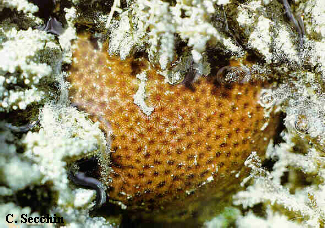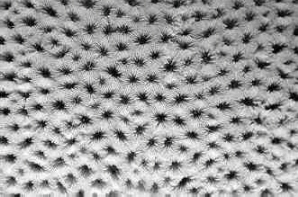

5. Siderastrea stellata
| Siderastrea stellata forms massive colonies that are roughly spherical. This coral is very similar to Caribbean species although it has larger calices, more delicate columellas and wider spaces between septa. The shallow water colonies are morphologically distinct from the deep water (greater than 5 m) colonies. The living shallow water colonies are red and are relatively small (diameter of 5 to 10 cm). Their calices |  |
 | measure 2 to 3 mm in diameter, are deep and round, and have an incomplete fourth cycle of septa. The deep water colonies are yellowish and relatively large (diameter greater than 20 cm). Their calices have diameters of about 5 mm, are shallow, and are approximate hexagons, in waters of high temperature and turbidity. Small colonies of this coral are flat, like discs, and, when alive, are red. |
| This species is endemic to Brazil. It is amply distributed in the area of Abrolhos and along the whole Bahian coast, particularly in the reefs located north of the city of Salvador. In Abrolhos it has a secondary role in the construction of reefs because, according to Laborel (1969a), it must compete for space with Mussismilia braziliensis. North of the São Francisco river this coral is abundant, even forming monospecific reefs on the coast of Rio Grande do Norte state. It occurs off the coasts of the Fernando de Noronha islands and on the Rocas Atoll. Its northern most limit is Piauí. South of Abrolhos, where the water becomes colder, the species becomes rarer. This species disappears completely beyond Cabo Frio, on the coast of Rio de Janeiro. According to Hetzel and Castro (1994) there exist accounts of this species covering several square meters at Tartarugas beach, at Buzios, on the coast of Rio de Janeiro state. |
[index] [previous] [home] [next] [taxonomy] [map of occurence]